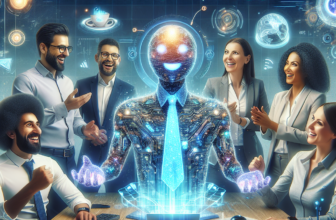Unleashing Innovation: Strategies to Unlock Employee Creativity in the Workplace
Introduction
In today's fast-paced business environment, the need for innovation has never been more critical. Companies that can harness employee creativity not only set themselves apart from competitors but also foster a culture of engagement and satisfaction. This article explores practical strategies for unlocking employee creativity in the workplace, ensuring that innovative ideas flow freely within your organization.
Section 1: Understanding Creativity and Innovation
Defining Creativity in the Workplace
Creativity is often viewed as the ability to come up with new ideas, concepts, and solutions. However, in a workplace context, it encompasses problem-solving, adaptability, and the application of original ideas to enhance productivity and efficiency. Studies show that creative employees tend to contribute positively to team dynamics and overall workplace morale.
The Innovation Process
Innovation is not merely having a great idea; it's a systematic process that includes stages like idea generation, feasibility analysis, and implementation. Understanding this process allows companies to build structured approaches that support creativity at every level. For further insights on how to harness innovation, refer to Harvard Business Review.
Section 2: Building a Culture of Creativity
Leadership and Support
A culture of creativity starts at the top. Leadership must advocate for innovation as a core value, providing guidance and resources to support creative initiatives. Leaders can model creative thinking by encouraging out-of-the-box solutions and collaborative dialogues.
Creating Safe Spaces for Ideas
Employees must feel safe to express unconventional ideas without fear of criticism. Creating ‘idea incubators' or holding informal brainstorming sessions can help foster this environment. Research indicates that organizations that encourage risk-taking see a 30% increase in innovation compared to those that do not—cite data from Forbes.
Section 3: Encouraging Collaboration and Teamwork
Cross-Departmental Projects
Breaking down silos is essential for innovation. Cross-departmental projects allow employees from different backgrounds to pool their knowledge, leading to groundbreaking solutions. Studies reveal that teams formed from diverse departments generate twice as many ideas compared to homogenous groups.
Brainstorming Sessions
Regular brainstorming sessions can stimulate employee creativity by encouraging the generation of a high volume of ideas. Techniques such as ‘brainwriting' or using collaborative software can help in structuring these sessions to maximize participation. For guidance on effective brainstorming methods, refer to Creative Bloq.
Section 4: Providing Tools and Resources
Technological Tools
Today's digital landscape offers numerous tools to aid creativity. Project management software, creative applications, and idea management platforms empower employees to capture and develop innovative ideas. Tools like Trello and Miro have gained popularity in facilitating collaborations and idea sharing.
Creative Resource Libraries
Establishing a repository of resources like books, articles, and workshops can serve as a wellspring of inspiration for employees. Whether physical or digital, these libraries foster a culture of learning and discovery, essential for nurturing creativity.
Section 5: Recognizing and Rewarding Creative Efforts
Incentives and Recognition Programs
Acknowledging and rewarding creativity can significantly motivate employees. Incentive programs tied to innovation, such as bonuses, recognition in company newsletters, or awards, can stimulate a culture of creativity. According to a Gallup study, employees who are recognized are 20% more productive compared to their unrecognized peers—source: Gallup.
Measuring Success
Quantifying the impact of employee creativity can be challenging. However, setting qualitative and quantitative KPIs can help demonstrate the value of creative initiatives. Metrics might include idea implementation rates, employee satisfaction surveys, and broader business performance indicators.
Section 6: Continuous Learning and Development
Professional Development Opportunities
Encouraging employees to engage in lifelong learning can significantly impact their creative capabilities. Workshops, courses, and seminars focused on creativity, design thinking, and innovation can boost employee confidence in their creative abilities.
Workshops and Training
Facilitated workshops led by creative professionals can impart valuable techniques for enhancing creativity. These sessions not only build skills but also team cohesion, which is vital for collaborative innovation.
Section 7: Addressing Challenges to Creativity
Identifying Common Barriers
Whether it’s management constraints, fear of failure, or a lack of resources, barriers to creativity can manifest in various ways. Identifying these barriers through employee feedback can help organizations devise strategies to mitigate them effectively.
Tackling Resistance to Change
Change is often met with resistance. Communication is key to overcoming this hurdle. Engaging employees in discussions about why creative initiatives are being implemented can pave the way for better acceptance and participation.
Section 8: Real-Life Case Studies of Success
Case Study: Google’s 20% Time
Google is well-known for its innovative policies, including the famed ‘20% Time' policy, which allows employees to spend 20% of their time working on projects of their choice. This initiative has led to the creation of successful products like Gmail and AdSense, demonstrating how empowering employees can lead to remarkable innovations.
Case Study: 3M and the Post-it Note
Another salient example is 3M’s development of the Post-it Note. Originally conceived as a failed adhesive project, an employee's ingenuity turned it into a billion-dollar product. This case reflects the potential of allowing time for creative exploration within a formal structure.
Q&A Section
Here are some common questions related to unleashing innovation in the workplace:
- What are the essential elements for fostering creativity in my organization? A supportive leadership, a culture of openness, and collaborative environments are crucial.
- How can I measure the impact of creative initiatives? By establishing KPIs and soliciting employee feedback, you can gauge the effectiveness of your programs.
- Is creativity important for all sectors? Yes, every industry can benefit from innovative approaches to problem-solving and process optimization.
FAQ Section
Below are frequently asked questions about unleashing innovation: strategies to unlock employee creativity in the workplace:
- What is the first step to promoting creativity in my company? Start by fostering a supportive culture and providing the necessary resources.
- How do I encourage employees to share their ideas? Regular feedback sessions and brainstorming workshops can create a safe space for sharing.
- Can technology support employee creativity? Absolutely, tools like collaborative platforms and creativity apps can enhance employee engagement and idea generation.
- How often should we conduct brainstorming sessions? Depending on your industry, holding them monthly or quarterly can sustain creative momentum.
- What are some successful examples of businesses that have embraced creativity? Companies like Apple, Google, and 3M have shown how creativity can lead to breakthroughs and sustained growth.
Resources
| Source | Description | Link |
|---|---|---|
| Harvard Business Review | Insightful articles on creativity and innovation practices. | Visit |
| Forbes | Expert insights on fostering workplace innovation. | Visit |
| Gallup | Research and tools related to employee engagement and creativity. | Visit |
| Creative Bloq | Resourceful articles focusing on creativity in business. | Visit |
| MindTools | Tools and resources for developing creative problem-solving skills. | Visit |
Conclusion
Unlocking employee creativity is not merely an option but a necessity for sustainable business growth. By implementing the described strategies, organizations can harness the innovative potential of their workforce, encouraging a culture that values and rewards creativity. The result? A more engaged, productive, and innovative organization ready to tackle the challenges of the future.
Disclaimer
This article was created with assistance from artificial intelligence (AI) to enhance research and drafting efficiency. All content has been reviewed and refined by human contributors.










